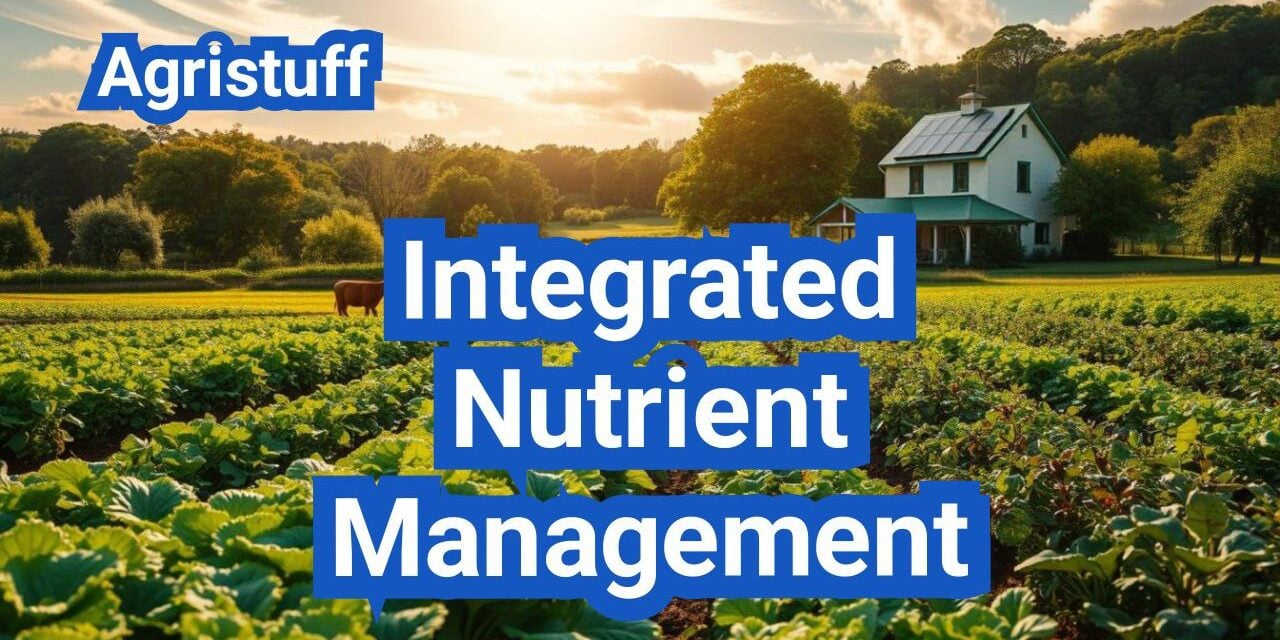Sustainable agriculture relies heavily on maintaining soil health and optimizing crop productivity. One effective approach to achieving this balance is through integrated nutrient management (INM), a holistic strategy that combines various nutrient sources to enhance soil fertility while minimizing environmental impacts.
By adopting Integrated Nutrient Management ( INM ), farmers can promote 4R nutrient stewardship – using the right nutrients, in the right amount, at the right time, and in the right place. This approach not only improves crop productivity but also contributes to sustainable agriculture by reducing waste and environmental degradation.
Key Takeaways
- INM combines various nutrient sources to enhance soil fertility.
- It promotes 4R nutrient stewardship for efficient nutrient use.
- INM improves crop productivity and sustainability.
- Adopting INM reduces environmental impacts.
- It supports long-term soil health and fertility.
What Is Integrated Nutrient Management?
At its core, Integrated Nutrient Management is about making informed decisions regarding nutrient application to enhance agricultural sustainability. It’s a dynamic approach that considers the complex interactions between soil, plants, and the environment.
Definition and Core Concepts
Integrated Nutrient Management (INM) is defined as the judicious use of all available sources of organic, inorganic, and biological components to manage soil fertility. This approach aims to maintain or enhance soil fertility while optimizing crop productivity.
The core concepts of INM include:
- Balancing nutrient inputs with crop needs
- Utilizing a combination of organic and inorganic nutrient sources
- Considering the temporal and spatial variability in soil nutrient status
- Monitoring and adjusting nutrient management strategies based on crop response and soil conditions
The Holistic Approach to Soil Fertility
INM adopts a holistic approach to soil fertility by considering the entire agricultural ecosystem. This involves understanding the complex interactions between soil organic matter, microbial activity, and nutrient cycling.
“A healthy soil is the foundation of a productive and sustainable agricultural system.” –
USDA
By managing soil fertility holistically, farmers can improve soil structure, increase water retention, and enhance nutrient use efficiency.
Benefits for Crop Productivity and Soil Health
The benefits of INM for crop productivity and soil health are multifaceted:
- Increased crop yields due to optimized nutrient availability
- Improved crop quality through balanced nutrition
- Enhanced soil fertility and structure
- Reduced environmental impact through minimized nutrient losses
By adopting INM practices, farmers can contribute to sustainable agriculture while maintaining or improving their productivity and profitability.
The Science Behind Balancing Nutrients

The science of balancing nutrients involves a deep understanding of the interactions between different nutrient sources and their impact on agricultural systems. Achieving a balance between nitrogen (N), phosphorus (P), and potassium (K) is crucial for optimal crop growth and soil health.
Understanding N-P-K Requirements
Crops require N-P-K in varying proportions, depending on the crop type, growth stage, and soil conditions. Nitrogen is essential for leaf growth and development, while phosphorus plays a critical role in root development, flower and fruit formation. Potassium helps with overall plant health and resistance to disease.
Understanding the specific N-P-K requirements of different crops is vital for effective nutrient management. Soil testing and crop monitoring can help determine the optimal N-P-K ratio for a particular crop.
Synergistic Effects of Combined Nutrient Sources
Combining organic and inorganic nutrient sources can have synergistic effects on crop productivity and soil health. Organic amendments like manure and compost can improve soil structure and fertility, while inorganic fertilizers provide readily available nutrients.
| Nutrient Source | Crop Benefit | Soil Benefit |
|---|---|---|
| Organic Amendments | Improved nutrient uptake | Enhanced soil structure |
| Inorganic Fertilizers | Rapid nutrient availability | Targeted nutrient delivery |
| Combined Sources | Optimized crop growth | Improved soil fertility and structure |
Nutrient Cycling in Agricultural Systems
Nutrient cycling is the process by which nutrients are converted from one form to another, making them available to crops. This process involves complex interactions between soil microorganisms, organic matter, and crop roots.
Effective nutrient cycling is critical for maintaining soil fertility and reducing the need for external inputs. Practices like crop rotation, cover cropping, and incorporating organic amendments can enhance nutrient cycling.
How to Assess Your Soil’s Nutrient Status
To manage nutrients effectively, you need to know your soil’s nutrient status. Assessing soil nutrient levels is a critical step in making informed decisions about fertilizer applications and soil amendments.
Conducting Proper Soil Testing
Soil testing is the foundation of understanding your soil’s nutrient status. It involves collecting representative soil samples from your field and analyzing them for various nutrient levels and other soil characteristics.
Key steps in soil testing include:
- Collecting soil samples at the right depth and time
- Using appropriate sampling patterns (e.g., grid or zone sampling)
- Sending samples to a certified laboratory for analysis
- Requesting relevant tests (e.g., N-P-K, pH, organic matter content)
As Dr. Harold Reetz, an agronomist, once said, “Soil testing is not just about getting a number; it’s about understanding what that number means for your crop’s productivity.”
“The goal of soil testing is to provide a basis for making informed decisions about nutrient management.”
Interpreting Soil Test Results
Interpreting soil test results requires understanding the nutrient levels and their implications for crop production. Soil test reports typically provide information on various nutrients, including nitrogen (N), phosphorus (P), and potassium (K), as well as other soil properties like pH and organic matter content.
| Nutrient | Soil Test Level | Interpretation |
|---|---|---|
| Nitrogen (N) | Low | Additional N fertilizer is likely needed |
| Phosphorus (P) | Medium | P application may be needed, depending on crop |
| Potassium (K) | High | K application may not be necessary |
Identifying Nutrient Deficiencies in Crops
While soil testing provides valuable information, observing crop nutrient deficiencies is also crucial. Visual symptoms of nutrient deficiencies can guide additional soil testing or fertilizer applications.
Common nutrient deficiency symptoms include:
- Yellowing leaves (nitrogen or sulfur deficiency)
- Purple or reddish leaves (phosphorus deficiency)
- Marginal leaf scorch (potassium deficiency)
By combining soil test results with observations of crop health, farmers can make more informed decisions about nutrient management, optimizing their fertilizer use and improving crop productivity.
Creating a SMART Nutrient Management Plan
To achieve optimal crop yields and minimize environmental impact, creating a SMART nutrient management plan is essential. This involves setting clear objectives, budgeting nutrients effectively, and establishing a timeline for implementation. A well-crafted plan not only enhances agricultural productivity but also contributes to sustainable farming practices.
Setting Specific, Measurable Goals
The first step in developing a SMART nutrient management plan is to set specific, measurable goals. This involves identifying the desired outcomes, such as improving soil fertility, increasing crop yields, or reducing nutrient runoff. By establishing clear objectives, farmers can tailor their nutrient management strategies to meet their unique needs.
For instance, a farmer might aim to reduce nitrogen application by 20% while maintaining current yield levels. This goal is both specific and measurable, allowing for precise adjustments to the nutrient management plan.
Nutrient Budgeting Techniques
Nutrient budgeting is a critical component of a SMART nutrient management plan. It involves calculating the balance between nutrient inputs and outputs. Effective nutrient budgeting techniques include:
- Assessing soil nutrient levels through regular testing
- Calculating nutrient requirements based on crop needs and yield goals
- Accounting for nutrient contributions from organic sources, such as manure or cover crops
- Adjusting nutrient applications based on the nutrient budget
As Dr. Harold Reetz, a renowned agronomist, once said, “A nutrient budget is like a financial budget; you need to know your income and expenses to make informed decisions.”
“The key to successful nutrient management is understanding the nutrient cycle and making informed decisions based on that understanding.”
Developing a Timeline for Implementation
Once the nutrient budget is established, the next step is to develop a timeline for implementation. This involves scheduling nutrient applications in accordance with crop growth stages and weather conditions. A well-planned timeline ensures that nutrients are available when crops need them most, maximizing efficiency and minimizing losses.
For example, a farmer might plan to apply nitrogen in split applications: at planting, during early growth, and again during the critical growth stage. This approach synchronizes nutrient availability with crop demand, enhancing uptake efficiency.
By following these steps and creating a SMART nutrient management plan, farmers can optimize their agricultural practices, improve crop productivity, and contribute to environmental sustainability.
Implementing 4R Nutrient Stewardship Principles
The 4R nutrient stewardship principles – Right Source, Right Rate, Right Time, and Right Place – are foundational elements in modern nutrient management strategies. These principles provide a framework for farmers and agricultural practitioners to optimize nutrient use efficiency, enhance crop productivity, and minimize environmental impacts.
Right Source: Matching Nutrients to Crop Needs
Selecting the right source of nutrients is critical for effective nutrient management. This involves choosing fertilizers or amendments that match the specific needs of the crop, soil type, and existing nutrient levels. Soil testing plays a crucial role in determining the appropriate nutrient sources.
- Conduct soil tests to determine nutrient deficiencies.
- Choose fertilizers that match the crop’s nutrient requirements.
- Consider organic amendments as part of an integrated nutrient management plan.
Right Rate: Calculating Proper Application Amounts
Applying nutrients at the right rate ensures that crops receive adequate nutrients without excess, which can lead to environmental pollution. Nutrient budgeting is a key technique in determining the right rate.
- Calculate the crop’s nutrient requirements based on yield goals and soil test results.
- Account for nutrients supplied by organic amendments, previous crops, and soil reserves.
- Adjust application rates based on in-season monitoring and crop response.
Right Time: Synchronizing with Plant Uptake
Timing nutrient applications to coincide with crop uptake is essential for maximizing efficiency. This principle involves understanding the crop’s growth stages and nutrient demand.
- Apply nutrients during periods of peak demand.
- Split applications to match different growth stages.
- Use slow-release or controlled-release fertilizers to synchronize nutrient availability.
Right Place: Optimizing Nutrient Placement
Optimizing nutrient placement ensures that nutrients are available to the crop roots where they are needed most. Techniques such as banding and subsurface placement can significantly improve nutrient use efficiency.
Effective placement strategies include:
- Banding fertilizers near the seed or root zone.
- Using precision agriculture technologies to optimize placement.
- Avoiding broadcast applications when possible to reduce loss and fixation.
By implementing the 4R nutrient stewardship principles, farmers can improve crop productivity, reduce environmental impacts, and contribute to sustainable agricultural practices.
Managing Organic Nutrient Sources Effectively

Effective management of organic nutrient sources is crucial for maintaining soil fertility and promoting sustainable agricultural practices. Organic nutrient sources, such as manure, compost, and cover crops, provide essential nutrients for crops while improving soil health.
Manure Management Best Practices
Proper manure management is critical to prevent nutrient loss and environmental contamination. Best practices include:
- Storing manure in covered facilities to reduce runoff and ammonia volatilization
- Applying manure at the right time and rate to match crop nutrient needs
- Incorporating manure into the soil promptly after application to minimize nutrient loss
Producing and Assessing Compost Maturity
Composting is a valuable method for converting organic waste into a stable, nutrient-rich soil amendment. To produce high-quality compost, it’s essential to:
- Maintain optimal carbon-to-nitrogen ratios
- Monitor moisture levels to support microbial activity
- Regularly turn the compost pile to ensure aeration
Assessing compost maturity is crucial to ensure its effectiveness and safety for use in agricultural applications. Maturity indicators include a stable carbon-to-nitrogen ratio, absence of weed seeds and pathogens, and a earthy, humus-like aroma.
Utilizing Cover Crops as Nutrient Contributors
Cover crops play a significant role in nutrient cycling and soil health improvement. Legume cover crops, such as clover and hairy vetch, are particularly valuable for their nitrogen-fixing abilities. Effective use of cover crops involves:
- Selecting cover crop species that match your climate and soil type
- Planting cover crops at the appropriate time to maximize growth and nutrient uptake
- Incorporating cover crops into your rotation to enhance soil fertility and structure
By implementing these strategies for managing organic nutrient sources, farmers can improve soil fertility, reduce environmental impacts, and promote sustainable agricultural practices.
Applying Integrated Nutrient Management in Organic Farming

The application of integrated nutrient management (INM) in organic farming systems is crucial for balancing nutrients and ensuring sustainable agricultural practices. Organic farming relies on INM to maintain soil fertility without the use of synthetic fertilizers, aligning with the principles of organic agriculture.
Nutrient Management for USDA Organic Certification
To achieve USDA organic certification, farmers must adhere to strict guidelines regarding the use of natural and organic nutrient sources. This involves maintaining detailed records of nutrient applications, soil testing, and crop rotation practices.
Nutrient Sources Allowed Under USDA Organic Certification:
- Composted manure
- Cover crops
- Green manure
- Organic fertilizers
Balancing Nutrients Without Synthetic Fertilizers
Balancing nutrients in organic farming requires a comprehensive understanding of soil science and nutrient cycling. Farmers can use natural amendments like compost, manure, and green manure to supply essential nutrients to crops.
| Nutrient | Natural Sources | Benefits |
|---|---|---|
| Nitrogen | Legume cover crops, compost | Improves soil fertility, supports plant growth |
| Phosphorus | Manure, bone meal | Essential for root development and plant maturation |
| Potassium | Compost, kelp meal | Helps with overall plant health and resistance to disease |
Designing Crop Rotation Strategies for Nutrient Cycling
Crop rotation is a key component of INM in organic farming, allowing farmers to cycle nutrients, improve soil health, and reduce pest and disease pressure. By rotating crops with different nutrient requirements and characteristics, farmers can create a balanced and sustainable nutrient cycle.
Effective crop rotation strategies involve planning multiple seasons ahead, considering factors like soil type, climate, and market demand. This proactive approach to nutrient management not only enhances soil fertility but also contributes to the overall sustainability of the farming system.
Mastering Advanced Application Techniques

Advanced nutrient application techniques are revolutionizing modern agriculture. By adopting these cutting-edge methods, farmers can significantly improve crop yields while reducing environmental impact.
Precision agriculture is at the forefront of this revolution, with techniques like subsurface banding and variable-rate fertilization leading the charge. These advanced methods allow for more efficient use of nutrients, resulting in healthier crops and reduced waste.
Implementing Subsurface Banding for Improved Efficiency
Subsurface banding involves placing nutrients below the soil surface, directly in the root zone of crops. This technique has been shown to improve nutrient uptake efficiency by reducing soil-fertilizer contact and minimizing nutrient loss through runoff or volatilization.
By using subsurface banding, farmers can:
- Reduce nutrient loss
- Improve crop yields
- Enhance soil health
Setting Up Variable-Rate Fertilization Technology
Variable-rate fertilization technology allows farmers to apply nutrients at different rates across a field, based on specific soil conditions and crop needs. This precision approach ensures that crops receive exactly what they need, when they need it.
The benefits of variable-rate fertilization include:
- Increased crop yields
- Reduced fertilizer waste
- Improved environmental stewardship
Addressing Phosphorus Stratification in No-Till Systems
No-till systems can sometimes lead to phosphorus stratification, where phosphorus accumulates near the soil surface. This can result in reduced phosphorus availability to crops.
To address this issue, farmers can use techniques like:
- Deep placement of phosphorus
- Use of cover crops to mobilize phosphorus
- Application of organic amendments to enhance phosphorus cycling
By adopting these advanced application techniques, farmers can optimize their nutrient management strategies, leading to more sustainable and productive agricultural practices.
Integrated Nutrient Management in U.S. Agriculture

Integrated Nutrient Management has become a cornerstone in U.S. agricultural practices, aiming to optimize nutrient use efficiency. This approach is crucial for maintaining the balance between crop productivity and environmental sustainability.
Adapting to Regional Soil and Climate Conditions
The diverse soil and climate conditions across the U.S. necessitate region-specific INM strategies. For instance, the humid south requires different nutrient management approaches compared to the arid west. Soil testing plays a vital role in determining the nutrient status and pH levels, which in turn guides the selection of appropriate nutrient sources and application rates.
Farmers in different regions are adopting various techniques to adapt to their local conditions. In areas with high rainfall, drainage management is critical to prevent nutrient leaching, while in drier regions, conservation tillage helps in retaining soil moisture and reducing erosion.
Following Tri-State Fertilizer Recommendations
The Tri-State Fertilizer Recommendations provide a widely accepted guideline for nutrient application rates in the U.S. These recommendations are based on extensive research and soil testing data, ensuring that nutrient applications are optimized for various crops and soil types.
| Crop | Nitrogen (N) | Phosphorus (P) | Potassium (K) |
|---|---|---|---|
| Corn | 150-200 lbs/acre | 50-75 lbs/acre | 100-150 lbs/acre |
| Soybeans | 0-50 lbs/acre | 30-60 lbs/acre | 50-100 lbs/acre |
Developing NRCS 590 Nutrient Management Plans
The NRCS 590 standard provides a framework for developing nutrient management plans that are both effective and environmentally friendly. These plans involve a comprehensive assessment of the farm’s nutrient resources, including soil testing, manure analysis, and crop nutrient requirements.
By following the NRCS 590 guidelines, farmers can create tailored nutrient management plans that not only enhance crop productivity but also minimize environmental impacts such as water pollution and greenhouse gas emissions.
Navigating Environmental Regulations and Concerns

As farmers and agricultural practitioners implement Integrated Nutrient Management (INM) strategies, they must also navigate a complex landscape of environmental regulations. These regulations are designed to protect water quality, reduce nutrient pollution, and promote sustainable agricultural practices.
Preventing Nitrogen Leaching in Vulnerable Areas
Nitrogen leaching is a significant concern in areas with sandy soils or shallow groundwater. To mitigate this issue, farmers can implement several strategies:
- Use cover crops to capture residual nitrogen
- Implement conservation tillage to reduce soil disturbance
- Apply nitrogen fertilizers at the right time and in the right amount
Contributing to Gulf of Mexico Hypoxia Reduction
The Gulf of Mexico hypoxic zone, often referred to as the “dead zone,” is a significant environmental concern. Nutrient management practices play a crucial role in reducing the size of this zone. Farmers can contribute to hypoxia reduction by:
- Implementing nutrient management plans that optimize fertilizer application
- Using conservation practices like buffer strips and wetlands restoration
- Participating in watershed-scale initiatives to reduce nutrient loading
Complying with State and Federal Water Quality Regulations
Farmers must comply with various state and federal regulations aimed at protecting water quality. Key regulations include:
| Regulation | Description | Impact on Nutrient Management |
|---|---|---|
| Clean Water Act | Federal law regulating water pollution | Requires nutrient management plans for certain agricultural operations |
| Total Maximum Daily Load (TMDL) | State-level regulation setting pollution limits for water bodies | May require reductions in nutrient applications to meet TMDL targets |
| State-specific nutrient management laws | Varied regulations across states addressing nutrient pollution | May dictate specific practices or restrictions on nutrient application |
By understanding and complying with these regulations, farmers can not only avoid potential penalties but also contribute to improved environmental outcomes. Effective nutrient management is crucial for maintaining water quality, reducing the risk of nitrogen leaching, and mitigating the impacts of hypoxia.
Monitoring and Adjusting Your Nutrient Strategy

Monitoring and adjusting your nutrient strategy is key to maximizing crop productivity while minimizing environmental footprint. A well-managed nutrient plan is not static; it requires continuous evaluation and adaptation to changing conditions.
In-Season Monitoring Techniques
In-season monitoring involves tracking crop health and nutrient status throughout the growing season. Techniques include regular soil testing to assess nutrient availability, crop scouting to identify early signs of nutrient deficiencies, and using remote sensing technologies to detect variations in crop vigor.
Remote sensing can provide valuable insights into crop health, allowing for timely interventions.
Conducting Post-Harvest Evaluation
Post-harvest evaluation is crucial for assessing the effectiveness of your nutrient strategy. This involves analyzing yield data to determine the impact of nutrient management on productivity, assessing soil nutrient levels after harvest to identify potential carryover effects, and reviewing weather patterns and other environmental factors that may have influenced nutrient availability.
Data collected during post-harvest evaluation can inform adjustments for the next growing season.
Making Data-Driven Adjustments for Next Season
Using data from in-season monitoring and post-harvest evaluation, farmers can make informed decisions to adjust their nutrient strategy. This may involve adjusting application rates based on soil test results and crop response, changing the timing or placement of nutrient applications to improve efficiency, and exploring alternative nutrient sources or products to better meet crop needs.
Continuous improvement is key to optimizing nutrient management and achieving long-term sustainability.
Calculating the Economic Benefits of Integrated Nutrient Management
By optimizing nutrient use, farmers can reap considerable economic benefits through Integrated Nutrient Management. This approach not only enhances crop productivity but also contributes to long-term soil health, leading to significant cost savings and improved yields.
Measuring Cost Savings from Reduced Fertilizer Use
One of the primary economic benefits of Integrated Nutrient Management (INM) is the reduction in fertilizer costs. By optimizing fertilizer application rates and using organic nutrient sources effectively, farmers can significantly cut down on their fertilizer expenses.
- Conduct thorough soil testing to determine nutrient levels
- Use crop rotation and cover crops to enhance nutrient cycling
- Implement precision agriculture techniques to minimize waste
Quantifying Yield Improvements and Quality Premiums
INM can lead to yield improvements by ensuring that crops receive the right nutrients at the right time. This balanced nutrient management can also result in higher quality crops, potentially leading to quality premiums in the market.
- Monitor crop health throughout the growing season
- Adjust nutrient applications based on crop needs
- Keep detailed records of yield and quality over time
Valuing Long-Term Soil Health and Productivity Gains
Investing in INM not only provides short-term economic benefits but also leads to long-term soil health and productivity gains. Healthy soils are more resilient to environmental stresses and require fewer inputs over time.
| Economic Benefit | Short-Term Impact | Long-Term Impact |
|---|---|---|
| Cost Savings | Reduced fertilizer costs | Lower input costs over time |
| Yield Improvements | Increased crop yields | Sustained productivity |
| Soil Health | Improved soil structure | Enhanced soil biodiversity and resilience |
In conclusion, the economic benefits of Integrated Nutrient Management are substantial and multifaceted. By measuring cost savings, quantifying yield improvements, and valuing long-term soil health gains, farmers can make informed decisions about their nutrient management strategies.
Building Sustainable Fertility for the Future
Implementing integrated nutrient management is crucial for maintaining soil fertility and promoting sustainable agriculture practices. By balancing N-P-K with organic inputs, farmers can enhance crop productivity while ensuring long-term soil health.
The strategies outlined in this article demonstrate how integrated nutrient management can be tailored to specific agricultural systems, from organic farming to advanced application techniques. By adopting these practices, farmers can contribute to a more sustainable future in agriculture.
As the global population continues to grow, the importance of sustainable fertility in agriculture cannot be overstated. Integrated nutrient management offers a pathway to achieving this goal, ensuring that future generations can continue to benefit from productive and healthy soils.
By embracing integrated nutrient management, farmers and agricultural professionals can play a vital role in shaping the future of agriculture, promoting environmental sustainability, and maintaining the productivity of our soils for years to come.
FAQ
What is Integrated Nutrient Management (INM)?
Integrated Nutrient Management is a holistic approach to managing soil fertility by balancing N-P-K with organic inputs to promote soil health and crop productivity.
Why is INM important in modern agriculture?
INM is crucial for sustainable crop production, as it enhances crop productivity, maintains soil health, and reduces the environmental impact of agricultural practices.
How does INM balance N-P-K with organic inputs?
INM balances N-P-K by combining synthetic fertilizers with organic nutrient sources, such as manure, compost, and cover crops, to create a nutrient-rich soil environment.
What are the benefits of INM for crop productivity and soil health?
INM enhances crop productivity by providing essential nutrients, while maintaining soil health by promoting nutrient cycling, improving soil structure, and supporting beneficial microbial communities.
How can I assess my soil’s nutrient status?
Conducting proper soil testing, interpreting soil test results, and identifying nutrient deficiencies in crops are essential steps in assessing your soil’s nutrient status.
What is 4R Nutrient Stewardship, and how can I implement it?
4R Nutrient Stewardship involves applying the right source, rate, time, and place of nutrient application to optimize nutrient use efficiency and minimize environmental impact.
How can I manage organic nutrient sources effectively?
Effective management of organic nutrient sources involves implementing manure management best practices, producing and assessing compost maturity, and utilizing cover crops as nutrient contributors.
Can INM be applied in organic farming?
Yes, INM can be applied in organic farming by meeting USDA organic certification requirements, balancing nutrients without synthetic fertilizers, and designing crop rotation strategies to promote nutrient cycling.
What are some advanced nutrient application techniques?
Advanced nutrient application techniques include subsurface banding, variable-rate fertilization, and strategies to address phosphorus stratification in no-till systems.
How can I monitor and adjust my nutrient management strategy?
Monitoring and adjusting your nutrient management strategy involves implementing in-season monitoring techniques, conducting post-harvest evaluation, and making data-driven adjustments for the next season.
What are the economic benefits of INM?
The economic benefits of INM include measuring cost savings from reduced fertilizer use, quantifying yield improvements and quality premiums, and valuing long-term soil health and productivity gains.
How does INM contribute to environmental sustainability?
INM contributes to environmental sustainability by reducing nitrogen leaching, mitigating Gulf of Mexico hypoxia, and complying with state and federal water quality regulations.
Conclusion of: Integrated Nutrient Management
Integrated nutrient management: what it is and why it matters
Integrated nutrient management is the practice of combining organic sources (manure, compost, cover crops) with mineral fertilizers to balance N-P-K while protecting soil health and water quality. At its core, integrated nutrient management follows site-specific plans that align nutrient supply with crop demand through the “right source, right rate, right time, and right place” so you hit yield targets without overapplying. In U.S. row-crop and specialty systems alike, integrated nutrient management is the most reliable path to consistent yields with fewer losses off-field. USDA Farmers.gov: Nutrient Management
The water-quality case for integrated nutrient management
Integrated nutrient management isn’t only about yield; it’s a frontline strategy to reduce nitrate leaching and phosphorus runoff that fuel algal blooms. By crediting manure and legumes, splitting applications, and improving placement, integrated nutrient management cuts losses to streams and aquifers while still meeting crop removal. Benchmarks like lower spring soil nitrate and fewer runoff events with dissolved P are common signals that integrated nutrient management is working as intended. USGS: Nitrogen and Water
4R + SMART: the guiding framework for integrated nutrient management
Successful integrated nutrient management pairs the fertilizer industry’s 4R Nutrient Stewardship (right source, rate, time, place) with USDA’s SMART planning mindset (site-specific assessment to align method, rate, and timing). In practice, integrated nutrient management uses 4R tactics within a whole-farm plan: you assess soils and rotations, choose sources (synthetic and organic), time and place nutrients to match uptake, and document outcomes to refine decisions each season. 4R Nutrient Stewardship
Start integrated nutrient management with soil testing
Every integrated nutrient management plan begins with credible soil testing: representative cores, correct depth, and consistent lab methods. Interpret results using land-grant guidance so you only build where you’re below critical levels and maintain where you’re adequate. Integrated nutrient management ties fertilizer and organic inputs directly to soil test categories, expected yield, and realistic removal, not guesswork. University of Minnesota Soil Testing Laboratory
Make a whole-field nutrient budget
Nutrient budgeting anchors integrated nutrient management by accounting for all inputs (fertilizer, manure, compost, biological N fixation, irrigation water) and all outputs (crop removal, measured losses). This stops you from double-counting manure N or over-applying P in no-till. Integrated nutrient management budgets are living documents you update after harvest to tighten rates and timing next season. USDA: Nutrient Management overview
Manure: the organic backbone of integrated nutrient management
When tested and credited properly, manure can be the most valuable organic input in integrated nutrient management, supplying N-P-K plus carbon to feed microbes and improve structure. Because nutrient content varies by species, bedding, storage, and timing, integrated nutrient management requires lab analysis, application records, and incorporation or injection to limit volatilization and runoff. UMN Extension: Manure Management
Compost to build soil within integrated nutrient management
Stable, mature compost is a slow-release source that boosts aggregate stability and water holding—two reasons integrated nutrient management often deploys compost in horticultural and high-value systems. Compost won’t replace fertilizers in nutrient-hungry crops, but integrated nutrient management uses it to enhance tilth, buffer pH swings, and smooth nutrient supply across the season. EPA: Composting at Home
Cover crops: nitrogen engines and nutrient scavengers
Legume covers fix atmospheric N, while grasses scavenge leftover nitrate—both central to integrated nutrient management. Choosing the right species and termination window determines whether N is available in time for the cash crop. Integrated nutrient management leverages mixes (e.g., cereal rye + vetch) to balance scavenging with later N release. SARE: Managing Cover Crops Profitably
Nitrogen: timing and placement in integrated nutrient management
N topsides yield, but mistimed N also topsides losses. That’s why integrated nutrient management favors split applications, sidedress or fertigation to match uptake, and banding or injection to reduce volatilization and denitrification risk. Weather-aware scheduling and in-season adjustments (SPAD/NDVI, tissue, or PSNT) keep integrated nutrient management on target. USDA: Nutrient Management
Phosphorus: manage stratification with placement
Surface-applied P can stratify at the top inch in long-term no-till. Integrated nutrient management tackles that with subsurface bands, starter placement only when warranted, and rates tied to soil test categories to avoid snowballing labile P. Integrating manure injection helps align integrated nutrient management with water-quality goals. 4R: Right Place
Potassium: base integrated nutrient management on soil CEC and crop need
K dynamics depend on clay type and CEC. Integrated nutrient management uses calibrated recommendations to build where K is deficient and to maintain above the critical level, avoiding luxury consumption that wastes dollars. Variable-rate K, guided by grid/zone samples, sharpens integrated nutrient management on fields with mixed textures. 4R: Right Rate
pH first: liming unlocks nutrients in integrated nutrient management
Before chasing micronutrients, correct pH. Lime raises availability of P, K, and most micros while improving microbial activity—so integrated nutrient management prioritizes pH to reduce tie-up and improve fertilizer efficiency. Use ECCE-rated sources and soil-test lime requirement to right-size applications within integrated nutrient management. Cornell Soil Health
Precision tools sharpen integrated nutrient management
Grid/zone sampling, yield maps, soil EC, and remote sensing allow variable-rate, spatially targeted applications. This precision reduces over-application on low-response zones and focuses nutrients where they pay. Integrated nutrient management built on precision data tends to lift partial-factor productivity and return on fertilizer dollars. USDA ERS: Precision Agriculture
Regional notes for integrated nutrient management: Corn Belt & Northern Plains
Cool springs and heavy residue can justify starter bands, but integrated nutrient management still hinges on soil tests and calibrated rates. Where P stratification is high, subsurface placement helps; on coarse soils, split N is essential. Regional trials from land-grants are your best calibration partner for integrated nutrient management. Iowa State University Extension: Crops
Regional notes for integrated nutrient management: Southeast & Coastal Plain
Highly weathered, acidic soils and intense rain events demand liming, sulfur where deficient, and split N with subsurface P placement. Because leaching and runoff risk are elevated, integrated nutrient management emphasizes cover crops, residue cover, and careful timing ahead of forecasted storms. USDA NRCS: Soil Health
Regional notes for integrated nutrient management: Northeast & Upper Midwest
Dairy-dense regions juggle manure logistics and winter restrictions. Injection or timely incorporation, plus cover crops to capture fall nutrients, are core integrated nutrient management moves. Frequent manure testing and documenting N availability by source keep integrated nutrient management economical and compliant. Cornell Nutrient Management Spear Program
Regional notes for integrated nutrient management: Irrigated West
Under irrigation, fertigation or frequent sidedress is common. Integrated nutrient management here focuses on spoon-feeding N, monitoring salinity/alkalinity, and matching P and K to soil tests while protecting canals and drains. Tissue testing and water quality checks round out integrated nutrient management for high-value crops. UC ANR: Irrigation Management
Environmental benchmarks inside integrated nutrient management
Set explicit goals to track progress: lower end-of-season soil nitrate, fewer runoff events with detectable dissolved P, and declining nutrient loads leaving the farm. Public dashboards and reports give context as you refine integrated nutrient management. Use these to align farm-level outcomes with watershed targets. EPA: Mississippi River/Gulf of Mexico Hypoxia Task Force
Recordkeeping is part of integrated nutrient management
Good records make compliance easy and learning faster: soil and manure tests, application logs (date, rate, source, method), weather notes, tissue tests, and yield maps. Integrated nutrient management relies on these records to validate savings, adapt to weather, and support cost-share or certification programs where applicable. USDA NRCS: Conservation Basics
Month-by-month checklist for integrated nutrient management
Winter: soil test, set yield goals, draft budgets. Early spring: plan split N and subsurface P/K where warranted. At planting: use starters only when conditions justify. In-season: sidedress/fertigate to match uptake; check fields after big rains. Post-harvest: sample where needed, seed covers, reconcile the budget. This cadence keeps integrated nutrient management responsive. USDA: Get started with Nutrient Management
Common pitfalls to avoid in integrated nutrient management
Skipping soil tests, surface-loading P in long-term no-till, ignoring pH, and failing to credit manure or legumes are the fastest ways to overspend and pollute. Integrated nutrient management avoids these by following calibrated recommendations, emphasizing placement, and relentlessly aligning rates with soil tests and realistic yield goals. USGS: Phosphorus and Water
Final thought
When you plan, measure, and adjust, integrated nutrient management lets you meet yield goals and protect soil and water at the same time. Treat your plan as a living system—tighten rates with fresh data, keep nutrients below ground, and use organic inputs to build resilience season after season. Integrated nutrient management is how U.S. farms make every pound count. Learn more at USDA Farmers.gov
Sources & References
- USDA Farmers.gov: Nutrient Management
- 4R Nutrient Stewardship
- University of Minnesota Soil Testing Laboratory
- UMN Extension: Manure Management
- EPA: Composting at Home
- SARE: Managing Cover Crops Profitably
- Iowa State University Extension: Crops
- USGS: Nitrogen and Water
- USGS: Phosphorus and Water
- EPA: Mississippi River/Gulf of Mexico Hypoxia Task Force
- USDA NRCS: Soil Health
- USDA NRCS: Conservation Basics










